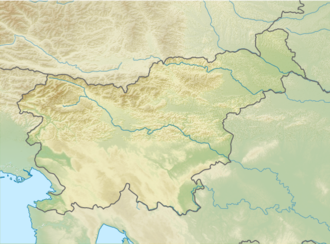| Lake Bohinj | |
|---|---|
 | |
| Location | Municipality of Bohinj, Triglav National Park |
| Coordinates | 46°16′56.31″N13°51′29.6″E / 46.2823083°N 13.858222°E |
| Type | Glacial lake |
| Primary inflows | Savica |
| Primary outflows | Sava Bohinjka |
| Catchment area | 107 km2 (41 sq mi) |
| Basin countries | Slovenia |
| Max. length | 4.35 km (2.70 mi) |
| Max. width | 1 km (0.62 mi) |
| Surface area | 3.18 km2 (1.23 sq mi) |
| Average depth | 30 m (98 ft) |
| Max. depth | 45 m (148 ft) |
| Water volume | 99.7×106 m3 (80,800 acre⋅ft) |
| Residence time | 0.3 to 0.5 years [1] |
| Surface elevation | 526 m (1,726 ft) |
| References | [1] |
Lake Bohinj (Slovene : Bohinjsko jezero), covering 318 hectares (790 acres), is the largest permanent lake in Slovenia. [2] [notes 1] It is located within the Bohinj Valley of the Julian Alps, in the northwestern Upper Carniola region, and part of Triglav National Park.


